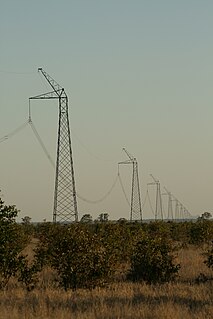Related Research Articles

A transformer is a passive electrical device that transfers electrical energy from one electrical circuit to another, or multiple circuits. A varying current in any one coil of the transformer produces a varying magnetic flux in the transformer's core, which induces a varying electromotive force across any other coils wound around the same core. Electrical energy can be transferred between separate coils without a metallic (conductive) connection between the two circuits. Faraday's law of induction, discovered in 1831, describes the induced voltage effect in any coil due to a changing magnetic flux encircled by the coil.

Electric power transmission is the bulk movement of electrical energy from a generating site, such as a power plant, to an electrical substation. The interconnected lines which facilitate this movement are known as a transmission network. This is distinct from the local wiring between high-voltage substations and customers, which is typically referred to as electric power distribution. The combined transmission and distribution network is part of electricity delivery, known as the "power grid" in North America, or just "the grid". In the United Kingdom, India, Tanzania, Myanmar, Malaysia and New Zealand, the network is known as the National Grid.

Alternating current (AC) is an electric current which periodically reverses direction and changes its magnitude continuously with time in contrast to direct current (DC) which flows only in one direction. Alternating current is the form in which electric power is delivered to businesses and residences, and it is the form of electrical energy that consumers typically use when they plug kitchen appliances, televisions, fans and electric lamps into a wall socket. A common source of DC power is a battery cell in a flashlight. The abbreviations AC and DC are often used to mean simply alternating and direct, as when they modify current or voltage.

Electric power distribution is the final stage in the delivery of electric power; it carries electricity from the transmission system to individual consumers. Distribution substations connect to the transmission system and lower the transmission voltage to medium voltage ranging between 2 kV and 35 kV with the use of transformers. Primary distribution lines carry this medium voltage power to distribution transformers located near the customer's premises. Distribution transformers again lower the voltage to the utilization voltage used by lighting, industrial equipment and household appliances. Often several customers are supplied from one transformer through secondary distribution lines. Commercial and residential customers are connected to the secondary distribution lines through service drops. Customers demanding a much larger amount of power may be connected directly to the primary distribution level or the subtransmission level.

The electric power industry covers the generation, transmission, distribution and sale of electric power to the general public and industry. The commercial distribution of electric power started in 1882 when electricity was produced for electric lighting. In the 1880s and 1890s, growing economic and safety concerns lead to the regulation of the industry. What was once an expensive novelty limited to the most densely populated areas, reliable and economical electric power has become an essential aspect for normal operation of all elements of developed economies.

A substation is a part of an electrical generation, transmission, and distribution system. Substations transform voltage from high to low, or the reverse, or perform any of several other important functions. Between the generating station and consumer, electric power may flow through several substations at different voltage levels. A substation may include transformers to change voltage levels between high transmission voltages and lower distribution voltages, or at the interconnection of two different transmission voltages.

Single-wire earth return (SWER) or single-wire ground return is a single-wire transmission line which supplies single-phase electric power from an electrical grid to remote areas at low cost. Its distinguishing feature is that the earth is used as the return path for the current, to avoid the need for a second wire to act as a return path.

A railway electrification system supplies electric power to railway trains and trams without an on-board prime mover or local fuel supply. Electric railways use either electric locomotives, electric multiple units or both. Electricity is typically generated in large and relatively efficient generating stations, transmitted to the railway network and distributed to the trains. Some electric railways have their own dedicated generating stations and transmission lines, but most purchase power from an electric utility. The railway usually provides its own distribution lines, switches, and transformers.

Induction cooking is performed using direct induction heating of cooking vessels, rather than relying on indirect radiation, convection, or thermal conduction. Induction cooking allows high power and very rapid increases in temperature to be achieved, and changes in heat settings are instantaneous.

A distribution transformer or service transformer is a transformer that provides the final voltage transformation in the electric power distribution system, stepping down the voltage used in the distribution lines to the level used by the customer. The invention of a practical efficient transformer made AC power distribution feasible; a system using distribution transformers was demonstrated as early as 1882.
A magnetic core is a piece of magnetic material with a high magnetic permeability used to confine and guide magnetic fields in electrical, electromechanical and magnetic devices such as electromagnets, transformers, electric motors, generators, inductors, magnetic recording heads, and magnetic assemblies. It is made of ferromagnetic metal such as iron, or ferrimagnetic compounds such as ferrites. The high permeability, relative to the surrounding air, causes the magnetic field lines to be concentrated in the core material. The magnetic field is often created by a current-carrying coil of wire around the core.

Electrical steel is an iron alloy tailored to produce specific magnetic properties: small hysteresis area resulting in low power loss per cycle, low core loss, and high permeability.

In electrical engineering, a load profile is a graph of the variation in the electrical load versus time. A load profile will vary according to customer type, temperature and holiday seasons. Power producers use this information to plan how much electricity they will need to make available at any given time. Teletraffic engineering uses a similar load curve.
The Electric Power Research Institute, Inc. (EPRI), is an American independent, nonprofit organization that conducts research and development related to the generation, delivery, and use of electricity to help address challenges in electricity, including reliability, efficiency, affordability, health, safety, and the environment.
An amorphous metal transformer (AMT) is a type of energy efficient transformer found on electric grids. The magnetic core of this transformer is made with a ferromagnetic amorphous metal. The typical material (Metglas) is an alloy of iron with boron, silicon, and phosphorus in the form of thin foils rapidly cooled from melt. These materials have high magnetic susceptibility, very low coercivity and high electrical resistance. The high resistance and thin foils lead to low losses by eddy currents when subjected to alternating magnetic fields. On the downside amorphous alloys have a lower saturation induction and often a higher magnetostriction compared to conventional crystalline iron-silicon electrical steel.

An electric power system is a network of electrical components deployed to supply, transfer, and use electric power. An example of a power system is the electrical grid that provides power to homes and industry within an extended area. The electrical grid can be broadly divided into the generators that supply the power, the transmission system that carries the power from the generating centres to the load centres, and the distribution system that feeds the power to nearby homes and industries. Smaller power systems are also found in industry, hospitals, commercial buildings and homes. The majority of these systems rely upon three-phase AC power—the standard for large-scale power transmission and distribution across the modern world. Specialised power systems that do not always rely upon three-phase AC power are found in aircraft, electric rail systems, ocean liners, submarines and automobiles.

An electrical grid, electric grid or power grid, is an interconnected network for delivering electricity from producers to consumers. It consists of:

Resonant inductive coupling or magnetic phase synchronous coupling is a phenomenon with inductive coupling where the coupling becomes stronger when the "secondary" (load-bearing) side of the loosely coupled coil resonates. A resonant transformer of this type is often used in analog circuitry as a bandpass filter. Resonant inductive coupling is also used in wireless power systems for portable computers, phones, and vehicles. WiTricity type magnetic resonance coupling systems add another set of resonant coils on the "primary" side which pair with the coils on the secondary side.
Ultra-high-voltage electricity transmission has been used in China since 2009 to transmit both alternating current (AC) and direct current (DC) electricity over long distances separating China's energy resources and consumers. Expansion of both AC and DC capacity continues in order to match generation to consumption demands while minimizing transmission losses. Decarbonization improvements will result from the replacement of lower efficiency generation, located near the coast, by more modern high-efficiency generation with less pollution near the energy resources.

At the time of commissioning in 2003, the 500 kW Chevron Solarmine solar photovoltaic (PV) system was the world's largest thin-film amorphous silicon solar PV system and one of the largest solar PV systems in the United States. Located at the Midway-Sunset Oil Field, Solarmine was the first solar PV system in California to power oil field operations.
References
- ↑ B. Kennedy, “Energy Efficient Transformers” McGraw-Hill, 1998.
- ↑ "J. Li, "Use of Energy Efficient Transformers in Asia", presented in Asian Energy Conference 2000, Hong Kong" (PDF). Archived from the original (PDF) on 2012-03-08. Retrieved 2010-07-06.
